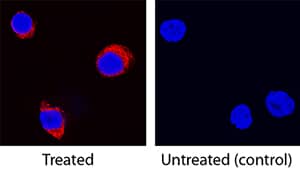Equine IL-5 Antibody
R&D Systems, part of Bio-Techne | Catalog # AF2470

Key Product Details
Validated by
Species Reactivity
Validated:
Cited:
Applications
Validated:
Cited:
Label
Antibody Source
Product Specifications
Immunogen
Leu20-Gly134
Accession # O02699
Specificity
Clonality
Host
Isotype
Endotoxin Level
Scientific Data Images for Equine IL-5 Antibody
Cell Proliferation Induced by IL‑5 and Neutralization by Equine IL‑5 Antibody.
Recombinant Equine IL-5 (2470-EL) stimulates proliferation in the TF-1 human erythroleukemic cell line in a dose-dependent manner (orange line). Proliferation elicited by Recombinant Equine IL-5 (50 ng/mL) is neutralized (green line) by increasing concentrations of Goat Anti-Equine IL-5 Antigen Affinity-purified Poly-clonal Antibody (Catalog # AF2470). The ND50 is typically 0.500-6.00 µg/mL.IL‑5 in Equine PBMCs.
IL-5 was detected in immersion fixed equine peripheral blood mononuclear cells (PBMCs) treated with calcium ionomycin and PMA using Goat Anti-Equine IL-5 Antigen Affinity-purified Polyclonal Antibody (Catalog # AF2470) at 15 µg/mL for 3 hours at room temperature. Cells were stained using the NorthernLights™ 557-conjugated Anti-Goat IgG Secondary Antibody (red; NL001) and counterstained with DAPI (blue). Specific staining was localized to cytoplasm. View our protocol for Fluorescent ICC Staining of Non-adherent Cells.Applications for Equine IL-5 Antibody
Immunocytochemistry
Sample: Immersion fixed equine peripheral blood mononuclear cells treated with calcium ionomycin and PMA
Western Blot
Sample: Recombinant Equine IL-5 (Catalog # 2470-EL)
Neutralization
Formulation, Preparation, and Storage
Purification
Reconstitution
Formulation
Shipping
Stability & Storage
- 12 months from date of receipt, -20 to -70 °C as supplied.
- 1 month, 2 to 8 °C under sterile conditions after reconstitution.
- 6 months, -20 to -70 °C under sterile conditions after reconstitution.
Background: IL-5
Interleukin-5 (IL-5) is a 40 kDa, secreted, heparin-binding, disulfide-linked homodimeric glycoprotein that belongs to the alpha-helical group of cytokines (1‑3). IL-5 is primarily produced by CD4+ Th2 cells, but other cell types such as eosinophils, endothelial cells, mast cells, visceral (airway) smooth muscle cells, bronchial epithelium, CD16+ NK cells and gamma delta T cells can also produce IL-5. Equine IL-5 is synthesized as a 134 amino acid (aa) precursor that contains a 19 aa signal sequence and a 115 aa mature segment. There are four alpha-helices, two potential N-linked glycosylation sites, and two cysteines that form interchain disulfide bonds with a second, antiparallel IL-5 molecule (3, 4). While human and mouse IL-5 have a potential NLS in their sequence, it is unclear if equine IL-5 has such a sequence. Mature horse IL-5 shares 71%, 89%, 88%, 83%, 66% and 63% aa sequence identity with mature human, bovine, feline, canine, mouse and rat IL-5, respectively.
The receptor for IL-5 consists of a 60 kDa ligand-binding subunit (IL‑5 R alpha) and a 120 kDa signal-transducing subunit ( betac). It is suggested that dimeric IL-5 binding to
IL‑5 R alpha recruits betac, which subsequently covalently links with IL‑5 R alpha. This trimeric complex then associates with another trimeric complex to form the physiologic IL-5 receptor (6). Following binding, IL-5 has targeted effects. It promotes the maturation and migration of eosinophils, partially through the effects of eotaxin. It mobilizes eosinophils and CD34+ progenitors from marrow. It also enhances Ig release from B cells and contributes to IL-4 production. Finally, it primes basophils for histamine and leukotriene release (1, 2, 7).
References
- Lalani, T. et al. (1999) Ann. Allergy Asthma Immunol. 82:317.
- Martinez-Moczygemba, M. and D.P. Huston (2003) J. Allergy Clin. Immunol. 112:653.
- Zabeau, L. et al. (2003) Curr. Drug Targets Inflamm. Allergy 2:319.
- Vandergrifft, E.V. and D.W. Horohov (1998) GenBank Accession # O02699.
- Geijsen, N. et al. (2001) Cytokine Growth Factor Rev. 12:19.
- Bagley, C.J. et al. (1997) Blood 89:1471.
- Mattes, J. and P.S. Foster (2003) Curr. Drug Targets Inflamm. Allergy 2:169.
Long Name
Alternate Names
Entrez Gene IDs
Gene Symbol
UniProt
Additional IL-5 Products
Product Documents for Equine IL-5 Antibody
Product Specific Notices for Equine IL-5 Antibody
For research use only

